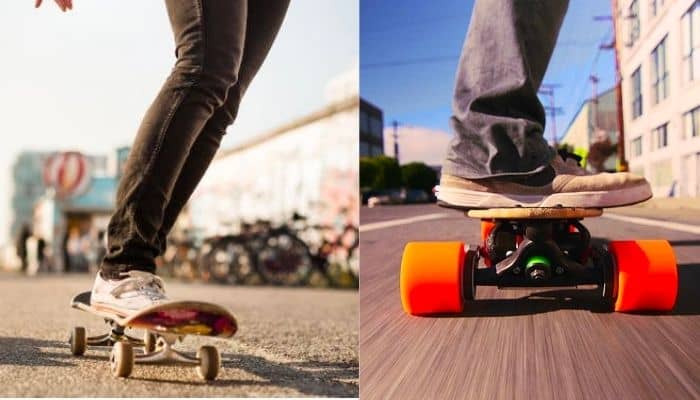The world of skateboarding has evolved dramatically since its inception in the 1950s. From a pastime for surfers to practice on land, it has grown into a global phenomenon with a diverse range of styles and disciplines. Among these, electric skateboarding and traditional skateboarding stand out as two distinct experiences, each with its own culture, community, and skill set. This first part of our two-part series delves into the origins, mechanics, and cultural significance of both electric and traditional skateboarding, offering insights into their unique appeal and the reasons behind their popularity.
The Evolution of Skateboarding
Traditional skateboarding’s roots can be traced back to the surf culture of California, where surfers sought a way to “surf” the streets when the ocean waves were calm. This desire led to the creation of the first skateboards, which were rudimentary in design, often just wooden planks with roller skate wheels attached. Over the decades, skateboarding evolved, with improvements in skateboard design and the construction of skate parks worldwide. It became not just a sport but a form of artistic expression, a community, and for many, a way of life.
Electric skateboarding, on the other hand, is a more recent phenomenon. It emerged in the late 1990s and early 2000s, with the advent of lithium-ion batteries and brushless electric motors. These technological advancements made it possible to create skateboards that could be propelled without the need for pushing, opening up the sport to a wider audience, including those who might be looking for a more convenient mode of urban transportation.
The Mechanics: Traditional vs. Electric Skateboarding
At its core, traditional skateboarding is about simplicity and physicality. A traditional skateboard is a symphony of basic components – a deck, trucks, wheels, and bearings – that requires the rider’s physical effort to push, turn, and perform tricks. This physical aspect is a crucial part of its appeal, offering a sense of freedom and a physical challenge that many enthusiasts find addictive.
Electric skateboards add a layer of complexity and convenience to the mix. Equipped with an electric motor controlled by a handheld remote or even body weight in more advanced models, these boards can reach speeds of up to 25 mph or more. They come with rechargeable batteries, making them an eco-friendly alternative to other forms of urban transportation. However, this convenience and speed come with a learning curve, as riders must learn to balance and control the board at higher speeds and navigate the rules of the road.
Cultural Significance and Community
The cultural impact of traditional skateboarding is profound. It has influenced fashion, music, art, and language, creating a subculture that values creativity, resilience, and a do-it-yourself (DIY) ethos. Skate parks and street skating spots have become communal spaces where individuals from diverse backgrounds come together to share their skills, learn from one another, and build a sense of community.
Electric skateboarding is building its own culture and community, albeit with a different focus. It attracts a mix of technology enthusiasts, commuters looking for an alternative to biking or public transportation, and traditional skateboarders intrigued by the new possibilities it offers. While it may lack the history and cultural depth of traditional skateboarding, the electric skateboarding community is rapidly growing, driven by a shared passion for innovation and the thrill of riding.

Personal Experiences and Lifestyle
The choice between electric and traditional skateboarding often comes down to personal preference and lifestyle needs. Traditional skateboarders relish the physical challenge and the sense of achievement that comes from mastering a new trick or navigating a complex skate park layout. The physical exertion involved in traditional skateboarding is not just about sport; it’s a form of expression, a way to push personal boundaries, and a method for interacting with urban landscapes in unique ways.
Electric skateboarders, while they may appreciate these aspects, often prioritize convenience, speed, and the ability to cover longer distances without the physical strain. For commuters, an electric skateboard represents a flexible and fun alternative to traditional transportation methods, allowing for the avoidance of traffic jams and the freedom to travel on their own schedule. The thrill of speed and the enjoyment of cruising effortlessly through city streets or along scenic paths also contribute to the appeal of electric skateboarding.
Challenges and Safety
Despite their differences, both forms of skateboarding share common challenges, particularly regarding safety. Traditional skateboarding involves a higher risk of falls and injuries due to the tricks and high speeds often attempted by riders. Skate parks and urban environments present their own hazards, from uneven surfaces to obstacles that must be skillfully navigated.
Electric skateboarding introduces additional safety considerations, primarily due to the speeds that can be achieved and the reliance on technology. Mechanical failures, battery issues, or remote control malfunctions can pose significant risks, especially for those riding in traffic or at high speeds. Both types of skateboarding require protective gear, including helmets, knee pads, and elbow pads, to mitigate the risk of injury.
Environmental Impact and Accessibility
Electric skateboarding offers an eco-friendly alternative to gas-powered vehicles for short commutes and urban travel. The rechargeable nature of electric skateboards, coupled with their efficiency, presents a sustainable option for environmentally conscious individuals. However, the production and disposal of batteries and the electricity used to charge them do have an environmental footprint that must be considered.
Traditional skateboarding, by contrast, has a minimal environmental impact, relying solely on human power. It’s also more accessible in terms of cost, with traditional skateboards being significantly less expensive than their electric counterparts. This accessibility has made traditional skateboarding a popular choice among younger individuals and those with limited budgets.

The Future of Skateboarding
As technology advances, the gap between electric and traditional skateboarding continues to narrow, with innovations in materials, design, and functionality enhancing the experience of both. The future of skateboarding looks to be inclusive, with technological advancements making electric skateboarding more accessible and traditional skateboarding benefiting from improved skate park designs and community support.
The integration of smart technology, such as GPS and Bluetooth connectivity, is set to redefine the electric skateboarding experience, offering features like route tracking, performance monitoring, and enhanced safety. Meanwhile, the enduring appeal of traditional skateboarding, with its emphasis on skill, community, and creativity, ensures its continued relevance and evolution.
Conclusion
Electric and traditional skateboarding offer distinct experiences, each with its own set of challenges, benefits, and enthusiasts. Whether one prefers the physicality and tradition of manual skateboarding or the convenience and innovation of electric skateboarding, both forms share a common spirit of freedom, adventure, and community. As skateboarding continues to evolve, it remains a vibrant and dynamic part of global culture, reflecting the changing landscapes of urban mobility, technology, and sport.

